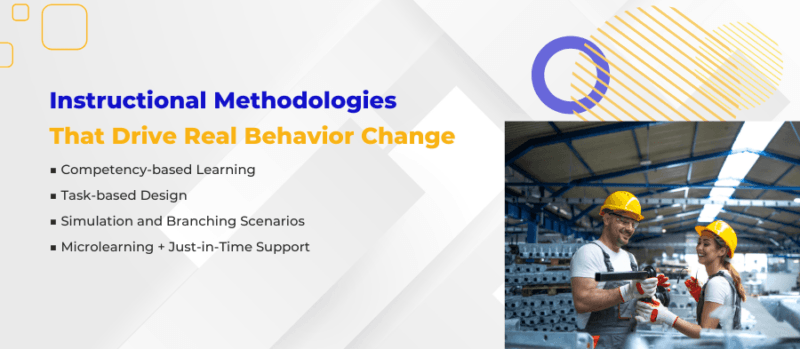Transforming eLearning: A Revolution in Training
In the modern manufacturing sector, innovation is at an all-time high. Products are becoming more intelligent, software advancements are accelerating, and customer demands are soaring. Field sales and service teams find themselves at the forefront of these exciting changes.
Despite the rapid evolution of technology, many manufacturing firms continue to rely on outdated training methods: tedious manuals, sporadic ride-alongs, and dense classroom sessions that fail to make an impact.
To effectively support field teams at scale, organizations need contemporary, blended eLearning programs designed specifically for product and software training. These solutions should be mobile, adaptable, and closely linked to real-world scenarios.
Identifying Knowledge Gaps in Sales and Service
Consider a manufacturer introducing a new series of industrial compressors. Sales representatives must effectively convey specifications, configurations, and unique selling points to engineers and procurement officers. On the technical side, service technicians must ensure flawless installation and calibration.
Now, factor in variables like regional specifications, software integrations, compliance requirements, and tight service-level agreements. A single knowledge gap in the field can lead to lost revenue, dissatisfied customers, or even equipment malfunctions.
Field representatives cannot afford lengthy courses; they require training that is relevant, concise, and immediately applicable.
The Blueprint of a Modern Training Curriculum
A comprehensive eLearning curriculum designed for field sales and service teams transcends mere digital manuals. Technical education must provide a dynamic framework that enables learners to absorb, apply, and adapt technical knowledge in real-time customer situations. The optimal curriculum is modular, mobile-responsive, and customized for different roles while being deeply integrated into daily workflows.
The key components of this curriculum typically include:
1. Core Product Education
The foundation consists of brief, high-impact microlearning videos that elaborate on product features, specifications, use cases, and key differentiators. These modules should clearly answer essential questions: What does this product do? Who benefits from it? How does it compare to competitors? Sales representatives use this information to convey value, while service teams leverage it to grasp system functionalities.
2. Scenario-Based Engagement
Sales teams require training that includes simulated customer conversations. Interactive decision trees and branching scenarios empower representatives to address common objections, tailor solutions, and navigate procurement discussions effectively. Such simulations build confidence and reinforce consultative selling techniques.
3. Service Task Guidance
Service technicians benefit from detailed walkthroughs for installation, calibration, troubleshooting, and repair tasks. These resources can feature annotated diagrams, interactive toolkits, and real-time video assistance, serving both as training and on-the-spot performance support tools.
4. Instructor-Led Engagements
For intricate products or niche features, live demonstrations are still invaluable. Virtual or face-to-face sessions create chances for reps to ask product experts questions, practice in smaller groups, or tackle unusual cases. These interactions help forge a connection with headquarters and foster teamwork.
5. Validation Through Certifications
A modern curriculum should also encompass practical assessments aligned with real-world challenges. Role-specific evaluations ensure that both sales and service representatives demonstrate proficiency and confidence before engaging with customers.
Success Story
A global HVAC company deployed a mobile-centric product training suite for service engineers and sales representatives across 14 countries. In just six months, warranty claims reduced by 23%, and cross-selling improved by 17%.
Effective Methodologies That Enhance Performance
Successful product training frameworks are underpinned by instructional methodologies that spark genuine behavioral changes in the field. These aren’t merely theoretical principles; they translate directly into improved sales conversations, expedited service calls, and bolstered representative confidence.

Image by CommLab India
Competency-Based Learning
Traditional training tends to focus on knowledge recall, but in the realm of field sales and service, simply knowing isn’t enough—representatives must be able to execute. Competency-based learning ensures training outcomes are gauged by demonstrated capability.
For sales reps, this could involve confidently detailing ROI calculations during pitches. For service engineers, it may mean accurately calibrating a product on-site independently. Assessments should reflect on-the-job performance rather than merely quiz scores.
Task-Centric Design
Forget generic modules titled “Product Overview.” Field teams thrive when training is aligned with real-world workflows. Learning paths should cater to the actual sequence of tasks representatives perform, such as qualifying leads, managing objections, assembling components, or troubleshooting error messages. This relevance accelerates proficiency and enhances job performance.
Interactive Scenarios and Simulations
Dynamic scenarios help transform static knowledge into actionable skills. For sales, this could involve a branch dialogue with a hesitant procurement officer. For service, it may focus on selecting the ideal solution based on evolving symptoms. These interactive simulations allow learners to make decisions, experience the outcomes, and cultivate muscle memory in a low-risk environment.
Example: A medical device company developed a virtual hospital simulation where representatives navigated intricate procurement discussions with surgeons and hospital administrators. The outcome? Shorter sales cycles and stronger customer relationships.
Microlearning and Instant Support
Field teams operate under tight schedules. They require easily accessible content at a moment’s notice—whether during a break, at a job site, or just before a client meeting. Microlearning modules (lasting 2–5 minutes) concentrate on a single subject or task. Furthermore, just-in-time support may encompass checklists, video guides, and mobile job aids that function as performance enhancers, not mere educational tools.
Together, these methodologies foster a practical, adaptable, and efficient learning journey. They mesh seamlessly with the dynamic nature of fieldwork—fast-paced, diverse, and interacting directly with customers—ensuring that training doesn’t just fulfill requirements but actively enhances performance where it counts.
Leveraging AI for Tailored Learning
Artificial Intelligence has transitioned from a futuristic concept in Learning & Development to a critical engine driving scalable, customized, and responsive training programs, particularly for dispersed field teams. In product training for sales and service roles, AI offers levels of specificity that traditional methods lack.
Smart, Adaptive Learning
Field representatives come with varying levels of experience and learning speeds. AI-driven adaptive platforms analyze a learner’s inputs, performance history, and preferences to create customized learning pathways.
An experienced sales engineer might bypass foundational modules to delve directly into competitive positioning or advanced integrations.
In contrast, a new recruit would receive additional support and scenario-based coaching. This strategy accelerates the learning curve for high achievers while offering assistance to slower learners—ensuring that no one gets left behind.
Localized Language Support
Global teams call for comprehensive solutions. AI-driven translation tools now provide context-aware localization that maintains both technical precision and intent. Rather than waiting weeks for human interpreters, organizations can roll out product updates in multiple languages within days.
This allows representatives across India, Mexico, Germany, and Brazil to receive consistent messaging and training, minimizing confusion and increasing compliance.
Smart Analytics for Insights
AI technologies not only personalize content; they also deliver profound insights into learning behaviors. Intelligent analytics monitor which modules are bypassed, where learners encounter challenges, and the duration spent on specific tasks.
This empowers learning and development teams to take proactive measures. For example, if 40% of representatives are skipping a crucial step in compressor installation, this could be a warning sign before warranty issues arise.
Predictive Readiness Assessments
Some sophisticated platforms utilize AI to forecast field readiness by assessing prior training patterns, assessment performance, and job data. Managers can then use this data to determine who is field-ready or requires further coaching.
Example: A pump manufacturer discovered that numerous service representatives repeatedly missed key installation steps in their assessments. A targeted refresher module was launched, leading to a 40% reduction in product callbacks within three months.
Instructor-Led Training as a Key Component
In a landscape increasingly dominated by digital learning, Instructor-Led Training (ILT) has evolved from a conventional delivery method to a strategic element within blended learning experiences. While eLearning and AI-driven modules enhance scalability and efficiency, ILT contributes depth, personalization, and the essential human connection field teams crave.

Image by CommLab India
Live training proves vital in key moments:
- New product launches or significant updates: When a new product is introduced, it’s not just about understanding features; representatives must possess the confidence to pitch, demonstrate, and troubleshoot before high-stakes clients. ILT allows for direct interaction with product specialists and provides hands-on experience.
- Soft skills cultivation: Mastering consultative selling, conflict resolution, and customer negotiation cannot be achieved solely through screens. ILT facilitates role-play, coaching, and feedback loops essential for building authentic real-world confidence.
- High-stakes client scenarios or intricate solutions: When the stakes escalate—such as deploying a multi-million-dollar system or managing a vital service contract—ILT creates a safe environment to rehearse and challenge assumptions while gaining insights from peers.
ILT transcends simple knowledge transfer; it establishes relationships among peers and mentors, reinforcing a collective sense of purpose across teams dispersed across different regions.
Example: A telecom equipment firm utilized eLearning to educate representatives on specifications and installation steps but reserved ILT bootcamps for navigating objections and managing price-value discussions. The result? Representatives closed deals more rapidly and reported heightened confidence during in-person negotiations.
Instead of delivering specs in a classroom—an area where eLearning excels—ILT should prioritize practice, discussion, and judgment-focused learning. This encompasses labs, expert panels, mock demonstrations, scenario rehearsals, and debriefing sessions designed to simulate the real pressures of the field.
When integrated thoughtfully, ILT transforms from a traditional burden into a powerful differentiator, ensuring that representatives are prepared not just to train but to perform with conviction and insight.
Engagement Strategies That Drive Success
No matter how well-crafted the training is, if it fails to capture attention, it will inevitably fall flat. In field sales and service training, engagement isn’t optional—it’s essential. Representatives juggle multiple responsibilities and maintain a fast pace, so training must align with their real-world setting, not vice versa.
Here are five effective engagement techniques that translate into improved learning outcomes and enhanced performance:
- Share authentic sales and service narratives: First-person accounts and case studies of successes (and failures) resonate with emotional undertones and practical insights. Representatives are more engaged when they hear how colleagues overcame challenges or salvaged opportunities. This sharing fosters a culture of learning rooted in authenticity and peer respect.
- Prioritize mobile-first design: Make your content suitable for smartphones and tablets, as field teams often engage in learning while commuting, in between customer visits, or even on-site. Ensure responsive design, voiceover videos, and accessibility in low-bandwidth conditions.
- Gamify the learning experience: Implement elements like progress indicators, achievement badges, timed challenges, and leaderboards. A little healthy competition fosters motivation and enhances retention. Gamification transforms routine modules into opportunities for recognition and rewards. Even basic mechanics such as unveiling new levels or earning digital certificates can boost engagement.
- Integrate field mentoring and peer coaching: Combine digital learning with live interactions from experienced representatives. A quick debrief after customer engagements or shared insights during service calls can convert theoretical lessons into actionable wisdom. Pairing newcomers with mentors nurtures culture and expedites onboarding.
- Encourage social learning: Promote community through discussion boards, user-generated videos, and shared playbooks. Urge representatives to contribute troubleshooting techniques, negotiation strategies, and demonstration scripts. This shifts training into a dynamic conversation that reinforces the notion that expertise exists not only at corporate headquarters but throughout the broader field.
Conclusion: Empower Your Frontline Without Overwhelming Them
Your field sales and service teams embody your brand, your products, and your commitments. They deserve training that values their time, adapts to their realities, and equips them for critical moments. With the right blend of adaptive eLearning, task-oriented designs, and meaningful human interactions, you not only cultivate better learners but also create stronger customer experiences.




